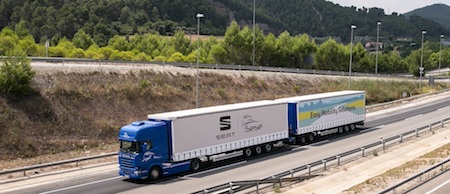 Spanish OEM Seat and transport provider Grupo Sesé have begun to pilot a double trailer truck combination to see if it can reduce the cost of delivering inbound components by a quarter.
Spanish OEM Seat and transport provider Grupo Sesé have begun to pilot a double trailer truck combination to see if it can reduce the cost of delivering inbound components by a quarter.
The double trailer approach could help reduce the number of large trucks on the road by 50%, which implies huge benefits in terms of sustainability, environmental responsibility, safety and efficiency, said Seat production and logistics vice-president, Christian Vollmer.
Use of the vehicle should result in 20% lower CO2 emissions, compared to the use of conventional trucks, through reduced fuel consumption per tonne of payload. It is six metres longer and carries 10 tonnes more payload than the longest lorry on Spanish roads at present, Seat said.
The duo trailer features two 13.6-metre long units pulled by a tractive unit manufactured by Scania, which, like Seat, is part of the Volkswagen Group. Total vehicle length is 31.7 metres and maximum payload is 70 tonnes.
“In addition, the duo trailer is more efficient in terms of multimodality with rail transport, as train wagon infrastructure is designed to make maximum use of 13.6-metre long trailers. For this reason, it could promote transport by train to the rest of Europe,” the company said.
“Designed for travelling on high-capacity roads, the duo trailer will also lower the number of trucks that travel on conventional roads,” the company added, pointing out that this could reduce the number of road accidents.
The truck is currently being tested on journeys between Zaragoza and Seat’s headquarters in Martorell, near Barcelona, north-east Spain. The pilot runs are being held in part to verify whether 20% fewer CO2 emissions and a 25% decrease in the cost of transporting components are achievable in real-world operations.
The longer-term goal is for the duo trailer to become standardised in Spain.
Seat and Grupo Sesé, which is based in Zaragoza, formerly introduced a 25-metre long truck combination in Spain two years ago – previously the longest vehicle on the country’s roads.

























![Global[1]](https://d3n5uof8vony13.cloudfront.net/Pictures/web/a/d/s/global1_726550.svgz)









